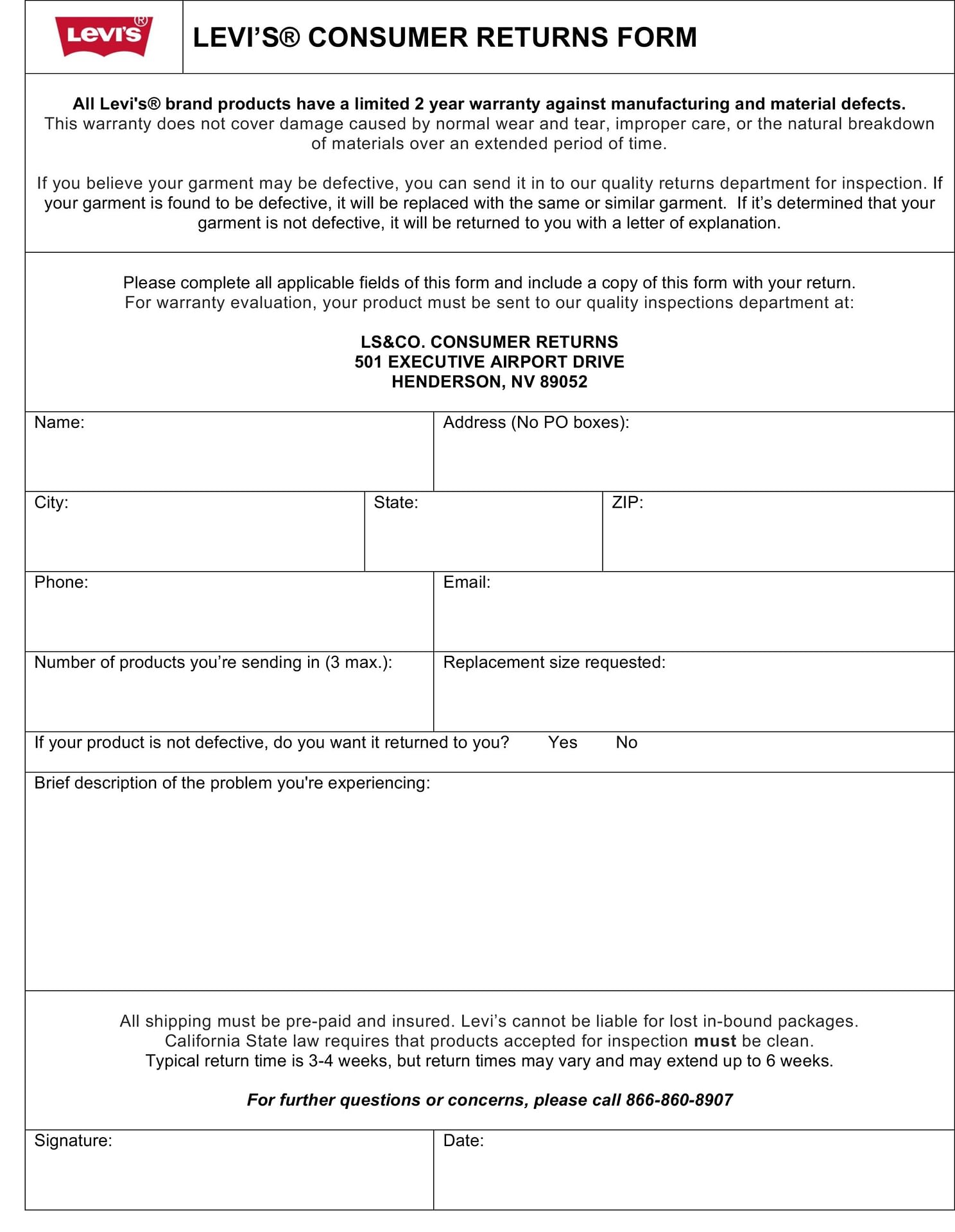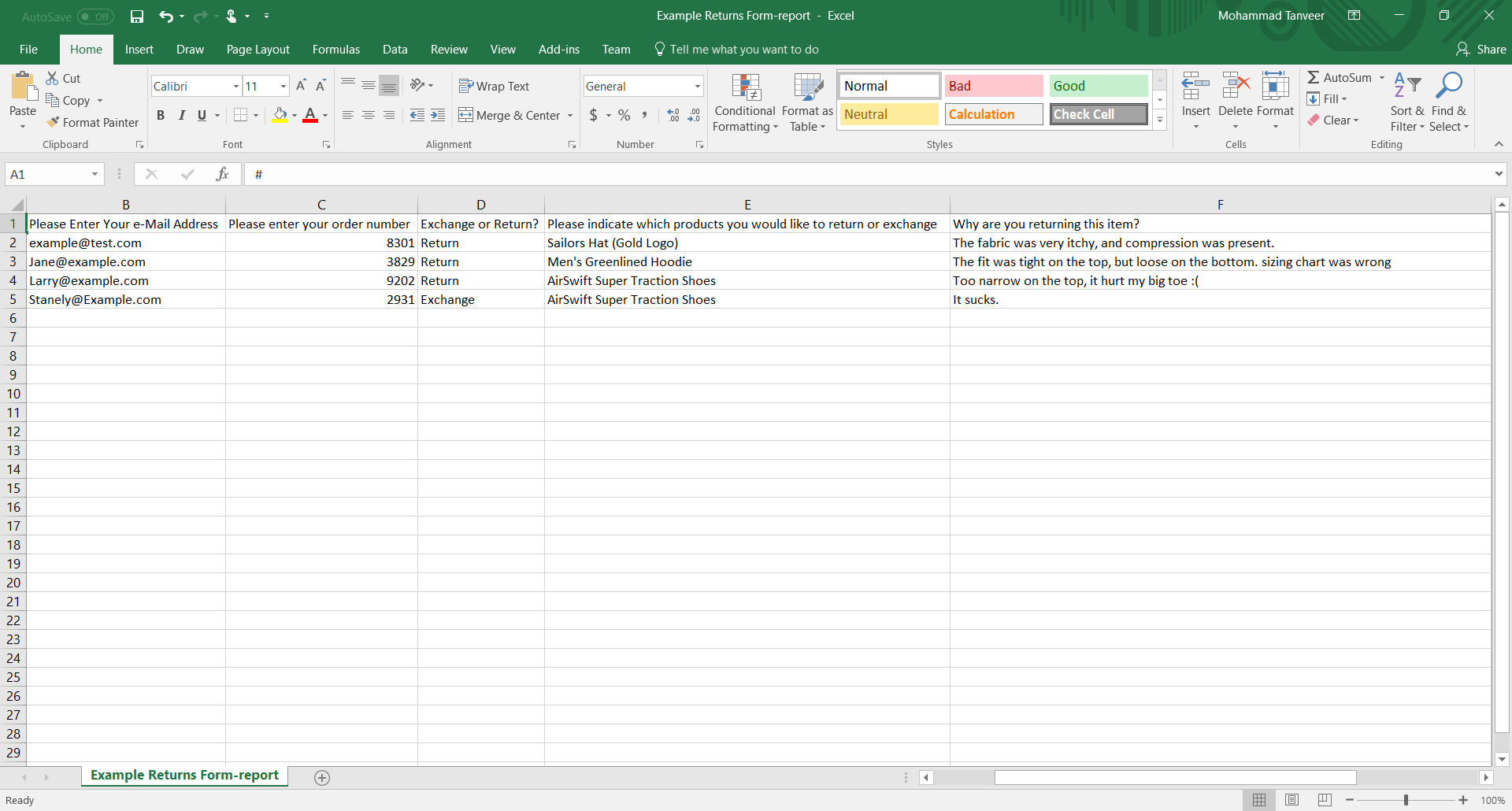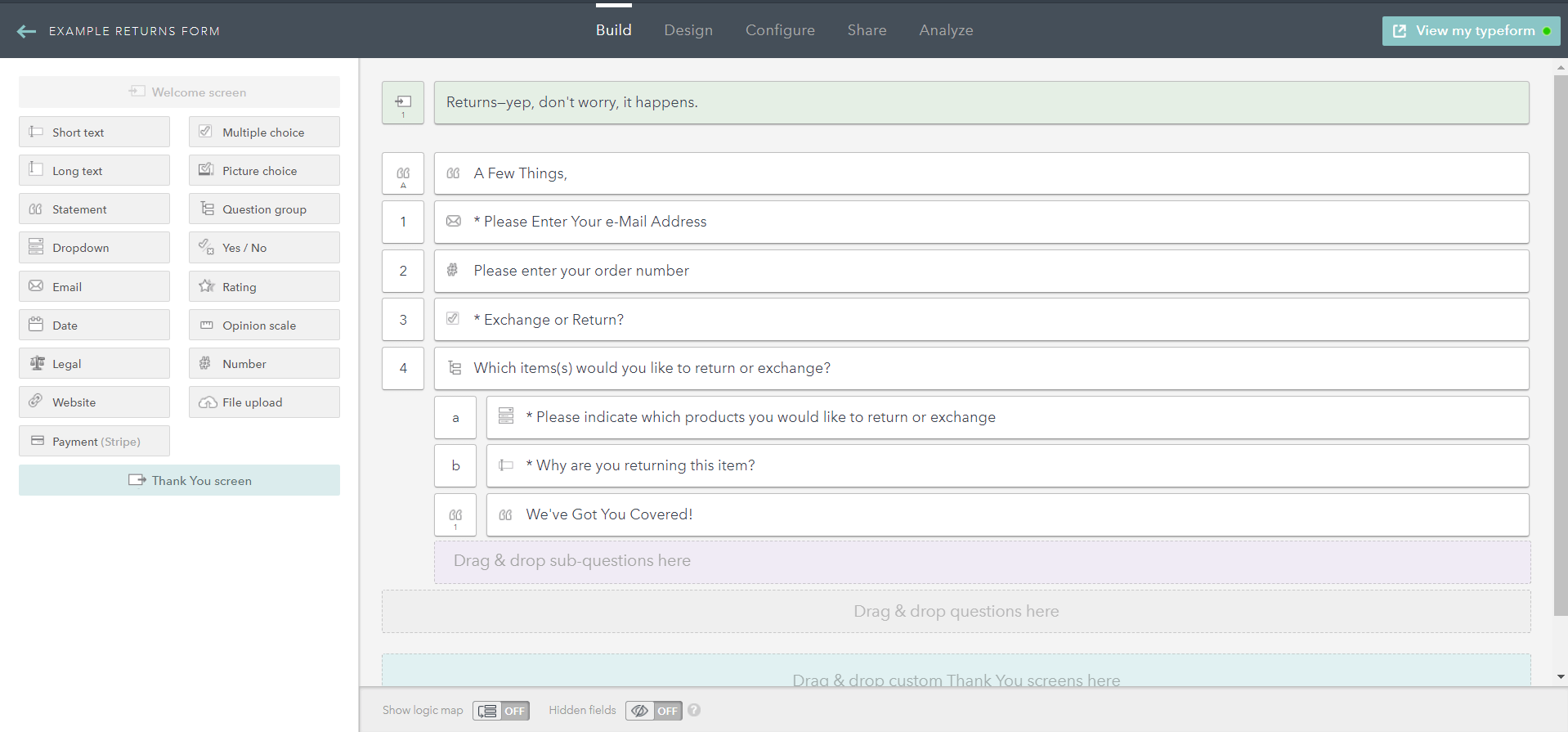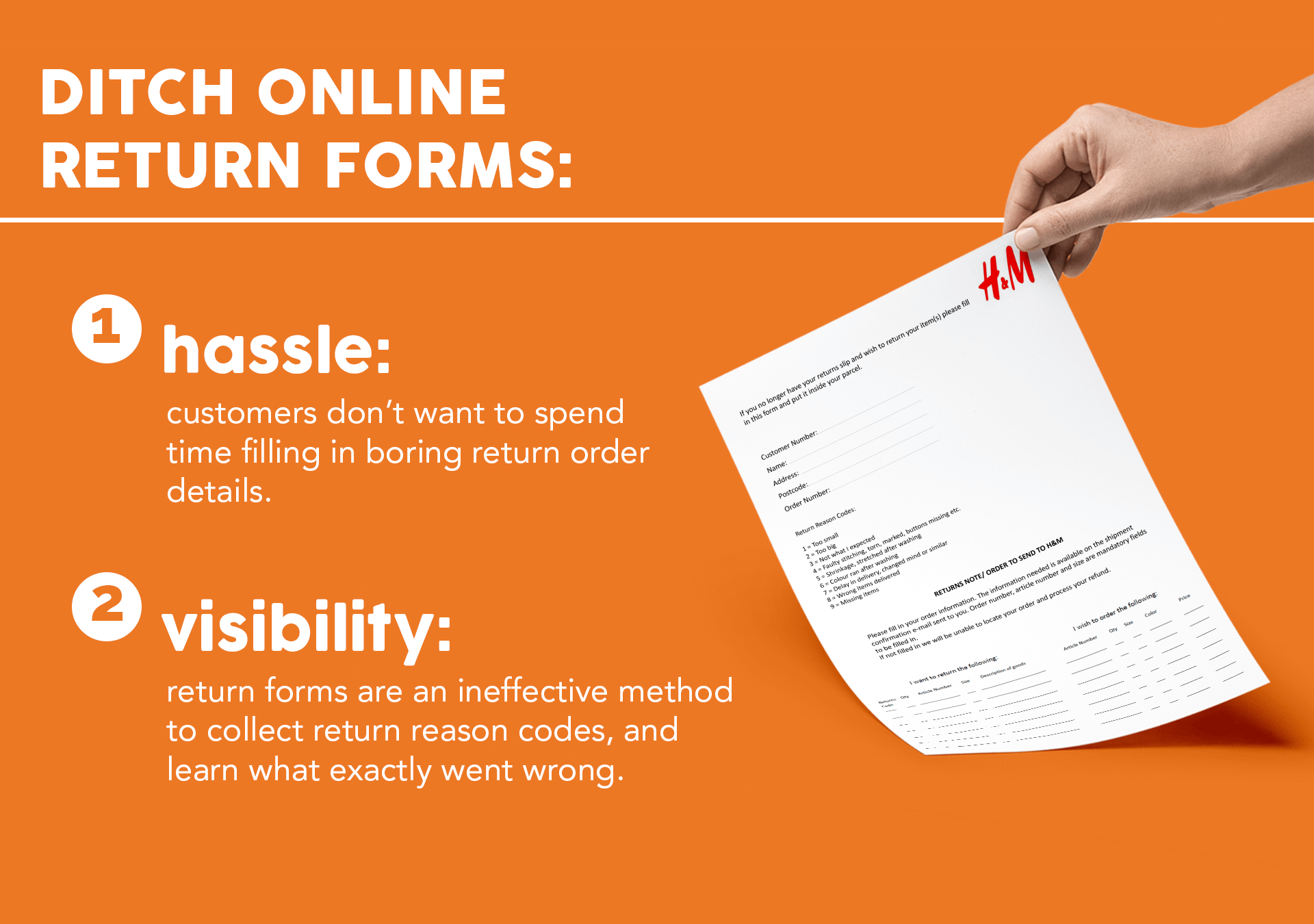The Pros and Cons of Switching from Manual to Automated Returns

Ditch Return Forms and Automate your Shopify Returns for Free.
What do retail giants like H&M, Urban Outfitters, and Levi’s have in common?
They’re all living in 1999.
Well, more specifically, their product return strategy is on the lagging edge of today’s consumer-centric standards.
These big-name retailers all force customers to fill out a physical form to authorize a return.
It’s Q4 of 2018, and unfortunately, many fashion and apparel retailers still haven’t figured it out— online product returns need to be a frictionless and data-driven experience.

Levi’s online product returns form, an example of what’s wrong with the currrent state of eCommerce returns.
If you’re a growing Shopify retailer using manual return management workflows like physical returns forms…stop it— like right now. It’s time for you to switch from manual to automated returns management systems.
Why Shopify Return Authorization Forms Don’t Work
While Shopify is a powerful ecommerce platform that empowers brands to sell their products in a streamlined fashion, a one-size-fits-all Shopify return management system isn’t a sound strategy for product development.
Without the proper tools and strategies, many Shopify stores include pre-paid shipping labels and return authorization forms in the original shipping box.
UPS and other shipping providers endorse this approach, claiming it provides a seamless shopping experience for the customer.
They couldn’t be more wrong. Pre-included forms & labels are a dangerous Shopify return strategy.
Presenting customers with even the idea of returning an online purchase elicits frustration. Thus, any further complications with experience will result in the loss of a sale and a returning customer.
Customers don’t want to take the time away from their busy lives to find a pen and shuffle through their pile of bills & invoices to fill out order details and long product numbers.
So while well-intentioned, return forms add more complications to the return process – both for the customer and your team members.
Shipping labels and return forms also reduce the amount of control the retailer maintains in the return process.
Logistics-based team members have no idea when a return is arriving, leading to workflow issues. And retailers can no longer enforce their return policies once a product arrives to their warehouse. This is a major flaw with a manual returns process, and why its important to consider switching from manual to automated returns.
Return Forms Don’t Tell You Anything
he only thing worse than a return is not knowing what caused it— was the sizing inaccurate? Did the customer not like the stitching? Did the fabric rip suddenly?
As Taylor Swift so eloquently put it, bandaids don’t fix bullet holes.
When a return arrives at a warehouse, chances are the receiving team will look at the order details and attempt to determine its proper disposition and proceed to refund the customer’s transaction.
Unfortunately, this is the end of the line for retailers who can’t extract any relevant data from their returns form. Even when they can, it’s simply too manual of a task to constantly update a messy excel spreadsheet with vague return reason codes that don’t provide any direct analytical value.
RMAs may provide generic return reason codes like: “didn’t fit” or “color inaccurate,” but rarely do these generalizations contribute anything of value. Frustrated customers often complete troublesome return forms as fast as possible, with little regard for accuracy or helpful feedback.
Ultimately, return forms make it difficult to keep digital records of interactions between your business and customers and add unnecessary complications to your return process.
The Solution, Online Forms
Aside from RMAs, another common return management practice in the world of Shopify is asking customers to email support to initiate a return.
While far less manual, this approach isn’t ideal as it still involves a tedious exchange between the retailer and the customer.
So, how can Shopify stores give customers a better return experience while making it easier to analyze each transaction?
The answer lies at the moment a customer decides to submit a return request.
Shopify retailers need to effectively gather accurate data on return reasons while reducing the time it takes for customers to request a return.
Luckily, with the advent of online feedback generation tools like TypeForm it has become easier than ever to collect essential information.

Lumenari opted to use TyepForm to make returns submission easier for customers… doing away with pen and paper methods to ease with data collection, and processing speed.
Many Shopify retailers have eliminated paper return authorization forms to adopt custom forms that automate their return process.
Here’s a live example of how Shopify retailers can automate their return management process with TypeForm.
Retailers can easily incorporate TypeForms into web pages, which helps Shopify retailers maintain their branding throughout the shopping experience. A seamless interface ultimately leads to fewer returns and more returning customers.
Using TypeForm, Shopify retailers can give customers a quick interface to request a return while collecting return reason codes and other details.
By switching from manual to automated returns, retailers can access each form entry and easily view data as it gets entered into the system.
TypeForm stores user entires, so retailers can analyze various aspects of their returns.
Many Shopify retailers resort to using Google Docs or Excel to manage each return interaction. This process is often error-prone and inefficient. Instead, it’s best to capture each piece of data quickly so analysts can draw the appropriate conclusions from product returns.
TypeForm enables users to export data in a CSV format, allowing retailers to analyze their data and make smarter business decisions.

While RMAs and shipping labels result in less retailer control in the return process, Shopify stores using TypeForm can leverage instant notifications for each return request submitted.
Using an online form not only allows for quick data collection, but it also provides a mechanism to expedite the handling and processing of returns.
Below is an example of an email your customer service or operations team might receive.
Using this system, your customer service team can handle returns faster than ever before, as it minimizes the long emails back and forth between customers and support.

With logical thinking and creativity, many Shopify retailers can automate initial customer support functions and optimize important data collection methods.
Not only will using online forms speed up the return process, but they will also contribute to an overall positive customer experience, which helps minimize the risk of consumer churn.

Disadvantages of Online Forms for Returns Management:
While TypeForm solves some of the fundamental return management problems, it leaves much to be desired regarding total Shopify returns automation.
Unlike complete end-to-end automated Shopify return management solutions, there are some disadvantages of the TypeForm return process approach. These include:
- Lack of Flexability:
- Complicated return situations arise, which can only get solved through a logical, human-based process.
- TypeForm offers logical decision-making structures but fails to encompass the experience on a customer and product level
- Lack of Integration:
- Using online forms for return management doesn’t contribute to overall logistical Shopify tasks like updating inventory each time an item gets returned.
- Retailers will still need to issue a refund on the back-end of Shopify manually.
- Large Manual Component:
- Customer support members will still need to work with the customer regarding the specifics of each requested return, so back and forth emails are not eliminated.
- For data collection and analysis purposes, retailers will still need to update their spreadsheets with new customer information and reason codes.
While TypeForm is far from a complete Shopify return solution, it’s an effective tool to alleviate some common top-level problems retailers have with data collection and returns initiation.
If your Shopify brand relies on shipping labels and manual RMAs for your return process, you should consider using an online form that allows your business to switch from a manual to automated returns management process.





